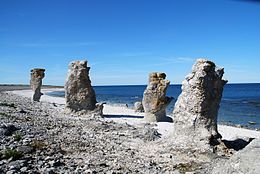Fårö

Rauks at Langhammars, Fårö
|
|
| Gotland (Sweden) | |
| Geography | |
|---|---|
| Coordinates | 57°57′N 19°09′E / 57.950°N 19.150°ECoordinates: 57°57′N 19°09′E / 57.950°N 19.150°E |
| Adjacent bodies of water | Baltic Sea |
| Area | 113.30 km2 (43.75 sq mi) |
| Administration | |
|
Sweden
|
|
| County | Gotland County |
| Municipality | Gotland Municipality |
| Demographics | |
| Population | 498 (2014) |
Fårö (Swedish pronunciation: [ˈfoːˈrøː]) is a Baltic Sea island just off north of the island of Gotland, itself off mainland Sweden's southeastern coast. It is the second-largest island in the province and it is a popular summer resort. It has its own dialect (Faroymal, a dialect of Gutnish), claimed to be the oldest language in Sweden. Formerly a socken which includes the Gotska Sandön island, on 1 January 2016, it was reconstituted into the administrative area Fårö District.
The island is separated from Gotland by the narrow Fårö-strait, and connected by two car ferries, operated by the Swedish Transport Administration. It has a total area of 111.35 square kilometres (42.99 square miles), of which 9.7 square kilometres (3.7 square miles) are water areas or islets.
On the islands of Fårö and Gotland are rock formations called "Rauk". They are a result of erosion during the Ice age and are unique to Gotland and Fårö.
The medieval Fårö Church is on Fårö.
One of the asteroids in the Asteroid belt, 9358 Fårö, is named after the island.
The name "Fårö" (in Gutnish "Faroy") is derived from the words "ö", meaning island, and "får-", which is a word associated with travel like in the Swedish word "färled" (fairway). The word Fårö probably means the island you have to travel to or the traveler's island. Mainland Swedes might misinterpret the name Fårö to be derived from får, the Swedish word for sheep, due to the many sheep on the island. However, the Gutnish word for sheep is "lamm" (similar to the Swedish word "lamm", meaning "lamb").
...
Wikipedia

